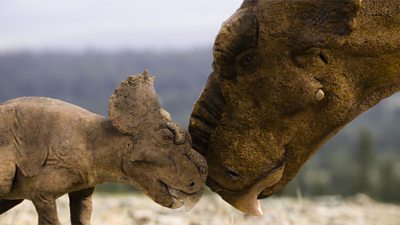Pachyrhinosaurus lakustai will be featured in the BBC's all-new Walking With Dinosaurs!
Dr. Emily Bamforth and her team are bringing you right to the Pipestone Creek Bonebed in the all-new documentary series. Look out for Episode 5, titled "The Journey North", releasing June 16 on AppleTV, Amazon Prime, and PBS.
MUSEUM DIRECTIONS
HEADING WESTGRANDE PRAIRIE (21MIN)
VALLEYVIEW (1.5HR)
WHITECOURT (3HR)
EDMONTON (5HR)
- Take the AB-43 North to Grande Prairie
- Stay in the left lane to continue onto Highway 43x
- At the roundabout, take the 2nd exit to continue on Highway 43x
- Keep right toward Beaverlodge and Dawson Creek
- Merge back onto Highway 43
- Exit the highway by turning left onto Range Rd 82A
- Then turn right onto 112 Ave, the museum will be on your right!
HEADING EAST
BEAVERLODGE (16MIN)
DAWSON CREEK (1HR 15MIN)
FORT ST. JOHN (2HR 12MIN)
- Head straight onto Hwy 2 South
- Stay on Hwy 2 South, entering Alberta
- Continue onto AB-43 East
- Exit the highway by turning right onto Range Rd 82A
- Then turn right onto 112 Ave, the museum will be on your right!

From out of town? Fly into the Grande Prairie Airport.
MORE ABOUT THE EPISODE
Based on an unprecedented discovery in Alberta, Canada, The Journey North tells the epic tale of one of the largest dinosaur herds that ever lived, the Pachyrhinosaurus, through the eyes of one of its youngest members, Albie. Every year, his herd makes an epic journey north as the seasons change. Along the way, he will encounter clashing bulls, tyrannosaur predators, and freak weather events.
Dr. Emily Bamforth said: “This episode is based on fifty years of research conducted at the Pipestone Creek Pachyrhinosaurus bonebed in northwest Alberta. The Pipestone Creek Bonebed, tucked away in Canada’s mixed boreal forest, captures the moment when a herd of potentially thousands of Pachyrhinosaurus, an enigmatic ceratopsian (horned) dinosaur with a distinctive bulbous bump on the nose, was preserved in a single event. The bonebed provides an unparalleled opportunity for palaeontologists to study growth, social structure, parental care, and behavior in a single community of dinosaur from a single point in time. The episode uses VFX and the integration of science-in-action to beautifully capture the immensity and scale of the bonebed, revealing the dramatic story of this dinosaur mega-herd, and the late Cretaceous world in which they lived.”

